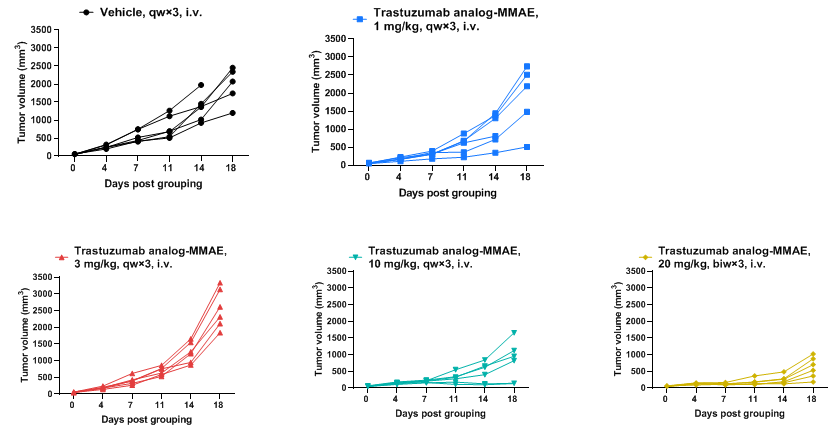Common name
|
B-hHER2 CT26.WT
|
Catalog number
|
322200
|
|
Aliases
|
ERBB2, CD340, HER-2, HER-2/neu,
HER2, MLN 19, NEU, NGL, TKR1,
VSCN2, erb-b2 receptor tyrosine kinase 2
|
Disease
|
Colon carcinoma
|
Organism
|
Mouse
|
Strain
|
BALB/c
|
|
Tissue types
|
Colon
|
Tissue
|
Colon
|
Description
The mouse
Erbb2 gene was replaced by human
ERBB2 coding sequence in B-hHER2 CT26.WT cells. Human ERBB2 is highly expressed on the surface of B-hHER2 CT26.WT cells.
Application
B-hHER2 CT26.WT cells have the capability to establish tumors
in vivo and can be used for efficacy studies.
Targeting strategy
Gene targeting strategy for B-hHER2 CT26.WT cells. The exogenous promoter and human
ERBB2 coding sequence was inserted to replace part of murine exon 2 and all of exons 3-7. The insertion disrupts the endogenous murine
Erbb2 gene, resulting in a non-functional transcript.
Protein expression analysis

HER2 expression analysis in B-hHER2 CT26.WT cells by flow cytometry. Single cell suspensions from wild-type CT26.WT and B-hHER2 CT26.WT cultures were stained with species-specific anti-HER2 antibody. Human HER2 was detected on the surface of B-hHER2 CT26.WT cells but not wild-type CT26.WT cells. The 1-A03 clone of B-hHER2 CT26.WT cells was used for in vivo experiments.
Tumor growth curve & Body weight changes

Subcutaneous tumor growth of B-hHER2 CT26.WT cells. B-hHER2 CT26.WT cells (1x105) and wild-type MC38 cells (1x105) were subcutaneously implanted into BALB/c mice (female, 6-7-week-old, n=6). Tumor volume and body weight were measured twice a week. (A) Average tumor volume. (B) Body weight. Volume was expressed in mm3 using the formula: V=0.5 X long diameter X short diameter2. Results indicate that B-hHER2 CT26.WT cells were able to establish tumors in vivo and can be used for efficacy studies. Values are expressed as mean ± SEM.
Protein expression analysis of tumor tissue

B-hHER2 CT26.WT cells were subcutaneously transplanted into BALB/c mice (n=6), and on 23 days post inoculation, tumor cells were harvested and assessed for human HER2 expression by flow cytometry. As shown, human HER2 was highly expressed on the surface of tumor cells. Therefore, B-hHER2 CT26.WT cells can be used for in vivo efficacy studies of novel HER2 therapeutics.
In vivo efficacy of anti-human HER2 antibody-drug conjugate (ADC)

Antitumor activity of anti-human HER2 ADC (Trastuzumab analog-MMAE, in-house) in BALB/c mice. (A) Anti-human HER2 ADC inhibited B-hHER2 CT26.WT tumor growth in BALB/c mice. Murine colon cancer B-hHER2 CT26.WT cells were subcutaneously implanted into BALB/c mice (female, 9-week-old, n=6). Mice were grouped when tumor volume reached approximately 50 mm3, at which time they were intraperitoneally injected with anti-human HER2 ADC Trastuzumab analog-MMAE (in-house) indicated in panel. (B) Body weight changes during treatment. As shown in panel A, anti-human HER2 ADC was efficacious in controlling tumor growth in BALB/c mice, demonstrating that B-hHER2 CT26.WT provide a powerful preclinical model for in vivo evaluation of anti-human HER2 antibodies. Values are expressed as mean ± SEM.
In vivo efficacy of anti-human HER2 ADC-individual tumor growth curves

Antitumor activity of anti-human HER2 ADC (Trastuzumab analog-MMAE, in-house) in BALB/c mice. Murine colon cancer B-hHER2 CT26.WT cells were subcutaneously implanted into BALB/c mice (female, 9-week-old, n=6). Mice were grouped when tumor volume reached approximately 50 mm3, at which time they were intraperitoneally injected with anti-human HER2 ADC Trastuzumab analog-MMAE (in-house) indicated in panel.













